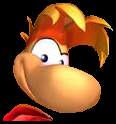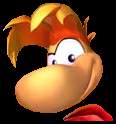Rayman
3 Characters - Part IICan
we talk a little about Rayman, and how you created his new look?
Stéphane:
The idea was to develop the character without tarnishing his "likeable
hero" image. We wanted him to be genuinely different from the Rayman of Rayman
2, without losing any of his strength. We really wanted the player to think "Ah!
A new Rayman!" the minute he sees the character.
So, to begin with, we
moved off in radically different directions from the former Rayman, to see how
we could change him. We tried giving him arms and legs, but that did nothing for
him. I felt he'd lost his personality! He's a very round character, so we tried
out a very angular version - too angular, in fact. Everyone thought he was a little
too childish. So we gave turned him into a fighter, then suddenly he looked like
a show-off and he wasn't likeable any more.
After many different attempts,
at last we found the right path - with a helping hand from Michel and Alexandra
Ancel, the creators of Rayman 1 and 2! We changed him without turning him completely
upside down, simply by getting rid of anything that might appear tacky or square.
Rayman's
kept the charismatic and likeably cocky side he had in Rayman 1, and the quick,
jumping side he had in Rayman 2. To that mixture, we added a dash more fighting
spirit!
In terms of movement, he's a very resourceful character. We exploited
the game design to add new movements. Now, Rayman can shoot out both his fists
either frontally or to the side. He can also roll in all directions - forward,
backwards, sideways. And he can combine his movements: jumping and launching his
fists, locking and rolling, and so on.
Lastly, we looked at everything
that could give him real attitude. We knew that a lot of players found the character
a touch too "nice". So we changed all his attributes to make them more dynamic.
We swapped the scarf for a hood with two drawstrings in front. His hair was remodeled
with a spiky cut to give him a mischievous look - less well-behaved - and that's
where the tests we did with a more angular and mature Rayman came in useful. His
shoes are a little more upmarket in design, too.
It should be pointed out
that, if we could do all of this, it was thanks to the technological potential
of the new-generation machines. Rayman's composed of precisely 2,206 polygons.
With such a large number, we had no problem giving him all the details and accessories
that go to make up his look.
Stanislas:
In the end, what really
took us both a long time was finishing off all those details. Just for his hair,
it took more than three days' hard graft to see if it worked. Since he's the main
character, he has a huge number of movements and he's present in all the engine
cinematics. There were more than 200 animations to create just with him. So we
had to be sure we could animate him with the modeling we'd opted for.
For
example, we wanted to make him smile, so we had to model some teeth for him. In
the same way, to pull certain facial expressions, we had to put a lot more surfaces
on this part of his body, whereas most of the time we see him from behind. But
that meant we could give him a whole stack of attitudes - astonishment, laughter,
irony - in the waiting animations or the engine cinematics.
Stéphane:
At the end of the day, we've now got a real character with a look that's
a better match for the spirit we wanted to deliver in episode 3. Now he really
behaves like a hero who doesn't take himself too seriously. And, visually, he's
totally different from Rayman 2, thanks to his superpowers.
Since
you mention the superpowers, did Michel Ancel also work with you on them?
Stéphane:
Obviously, we put a few ideas to him, but most of the time the work was
done on our side. As soon as we had a solid basis for Rayman in his normal condition,
it became much easier to produce the variations. What's more, we were very quick
to identify what we wanted.
We had one simple aim: the player should see
powers that give you a feeling of strength, while maintaining a lightness of tone.
We didn't want to create a fat brute, straight out of some punch-up game. Nor
did we want ridiculous powers. So we started with two key elements: a different
color of costume and a mechanical accessory for each power. Stanislas dreamed
up the operating principles for the mechanical accessories, then I did a few sketches
to make them more cartoon-like and exaggerate the concept. For example, a simple
hook became a really cartoony "mantrap".
Let's
talk about the other characters, apart from Rayman and the enemies. Who are they?
Stanislas:
There are two other kinds of characters.
On the one hand, there
are secondary characters who are really important in the game. That's the case
with Globox, who follows Rayman nearly all the time, or Murfy, who accompanies
Rayman through the first six levels. Here too we worked on giving them both a
genuine cartoon personality and all the movements that the programmers needed.
Take Globox. We animated him to get him across all the levels - he walks, he jumps,
he runs. And he also has loads of reactions that are very specific to his personality:
as soon as he sees an enemy, he panics and runs off to hide. When the player shoots
a fist at him, his belly starts moving in all directions because of the black
Lums.
On the other hand, there are what we call "environmentals". These
are animals who live in the universe but who don't have proper roles as such.
They're important because they create the player's sense of immersion, the feeling
of moving through a living world. At the same time, they shouldn't distract the
player from the action or make him believe he has to use them to get through the
game. So we were obliged to do something very simple.
Can
you give me an example of one of these "environmentals"?
Stanislas:
At the start of the game, Rayman goes through a forest on a summer's night.
The atmosphere is very restful and magical. In the clearings, we put turtles who
potter around peacefully. We added a little kitsch detail: when two turtles are
very close to each other, lots of little hearts appear. We even added a very simple
interaction: if the player kicks a turtle, it goes soaring off into the air and
lands up a few yards away.
In the end, how many
creatures did you create and animate for Rayman 3?
Stanislas:
If you include everyone, you end up with around sixty characters. That's quite
a bestiary, isn't it?!
Source: Ubisoft/Raymanzone
<<<
back to Interviews |





